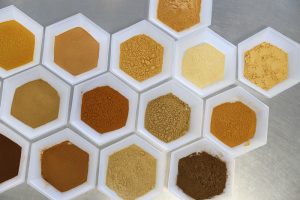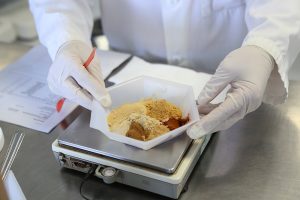By Skye Sturgeon, DAOM
This article was originally published in the Fall 2022 edition of the AIM Newspaper. Read the full paper for free.
Convenient and customizable, extract powders and granules of herb prescribing continue to be popular with both practitioners and patients. The use of these products has resulted in increased acceptance and compliance with herbal therapies. However, there remains quite a bit of misunderstanding about the character of these products.
What exactly is an extract?
An extract is a liquid mixture obtained from adding a raw material to a solvent such as ethanol or water. When speaking of an herbal extract, the raw materials are whole herbs. It is not necessary to cook or heat the solvent to obtain the extraction, although it is common and more efficient to do so. Extracts may be dispensed and administered as liquid extracts (e.g., decoctions) or as tinctures (usually containing a significant amount of alcohol). They may also be sold in a form in which the water has been removed. Although pills and tablets may, but not necessarily, be made from extracts, the topic at hand indicates that extract powders or granules are simply dried decoctions.
Historically, the knowledge base of Chinese herbology was developed using water-based decoctions (with some herbs extracted in ethanol with water) and was antecedent to the use of organic solvents, which may yield a different chemical profile. In Chinese medicine, herbal extracts are “full spectrum” extracts rather than “standardized” extracts. Full spectrum extracts reflect the natural constituent yield that is obtained from a water-based extraction. Standardized extracts focus on specific ingredients found within the herbs, endeavoring to “standardize” active ingredients from batch to batch. While the Chinese pharmacopeia does require minimum levels for certain marker chemicals found in many herbs, most herbs have numerous compounds that may contribute to therapeutic effects. Additionally, many chemicals in herbs are unknown or may be created only in conjunction with other herbs in a formula. Standardization to a particular ingredient may imbalance the chemical profile of the herb and lead to the spiking of herbs with isolated constituents, which may cause unpredictable results.
Are you interested in becoming a certified acupuncture professional?
Visit the links below to explore our specialized acupuncture programs at a campus near you:
Differentiation Between Granules and Extract Powders
Based on empirical knowledge, the producers of extract powders and granules have learned to treat every herb and every formula in such a way to optimize the extraction. Although arguably superior to a decoction cooked on one’s stove top, these extractions are similar in concept to what we learned in Chinese medicine school. The main advantage is ease of use and increased compliance by patients. No cooking or special preparation is necessary; just add hot water.
Extract powders and granules are remarkably similar. Each begins with bulk, whole herbs (singly, or as a formula) decocted primarily in an aqueous solution, using modern equipment, including pressurized, temperature gradient cookers with volatile component recovery systems. The resultant liquid is condensed under low heat using vacuum evaporators into a syrup.
The next step is where these two products differ. In an extract granule system, the condensed liquid extract is atomized and sprayed as an aerosol onto an excipient/binder, usually starch, sugar, dextrin, or maltodextrin. This type of wet granulation is called flow-coating. (There are alternate methods of creating granules.) The process creates a wet mass of product, sometimes called a “slug,” which is then milled and/or forced through a sieve to form uniform granules. Any remaining liquid portion of the granules is removed by a drying process such as a drying cabinet or heat tunnel.
According to The Pharmacopeia of the People’s Republic of China, granule products contain at least 20% excipient to a maximum of 60%. The amount of carrier needed depends on the herbs used among other factors, but this carrier constitutes a significant portion of the finished product. Therefore, these carriers are sometimes called “diluents” in the manufacturing realm.
Granulation is most commonly and extensively used for the manufacturing of tablets and capsules. Herbal extract granules undergo the same process and can be thought of as stopping the finished product before it is made into a tablet or capsule. There is no essential difference in potency between extract granules and the tablets or capsules that are made from them.
Some herb extract granule manufacturers make formulas by mixing single herb extract powders together rather than the traditional way of cooking them together before making the finished product.
In contrast, when making extract powders, the condensed liquid extract is spray-dried. Spray-drying is a method of producing a dry powder from a condensed liquid or slurry by rapidly drying with a hot gas such as nitrogen, oxygen, or air. This is the preferred method of drying many thermally sensitive materials such as foods and pharmaceuticals. The resulting powder has a consistent particle size distribution, is free-flowing, and dissolves completely and easily when reconstituted with water. Spray drying offers another significant advantage in that the final product can be made with little or no fillers. This means that gram for gram, spray-dried extract powders will have a higher potency than granules, which contain a significant percentage of excipients. Mayway’s Plum Flower® Formula Extracts are pure herbs only with no fillers or excipients.
A disadvantage to this method is that spray-dried powders are very hygroscopic, and even insignificant amounts of exposure to water vapor (such as that normally found in air) may cause them to clump into a gummy or solid mass. Mayway’s Plum Flower® Single Herb Extracts are mixed with about 10% dextrin to alleviate this issue. Keeping the cap tightly closed will lessen the potential of this occurring. To further mitigate this potential problem, all Plum Flower® Extracts are packaged with a desiccant pack in the bottle and the cap of the bottle also contains a desiccant behind the cardboard liner, which should be removed after opening.
Concentrate vs Concentrated
Herbal extract powders and granules are often referred to as “concentrates,” which is a form of substance that has had all or most of the solvent removed. In the case of herbal extract powders and granules, the liquid solvent (water) has been removed, and they can be re-constituted by dissolving the powder or granules in water. This is a common way that extract powders are consumed by patients, i.e., adding water to reconstitute and then drinking as a “tea”, just like a whole herb stovetop tang decoction.
To help understand this, I compare extract powders and granules to another herbal beverage that I first enjoyed while traveling in China, where I was introduced to Vietnamese “3 in 1” instant coffee. This coffee is made by brewing coffee, spray-drying it, and then adding spray-dried non-fat milk, sweetener (glucose), and maltodextrin. When you add a 16 g sachet to hot water, you get a fine cup of coffee!
“Concentration” is the measure of how much of a given substance there is mixed with another substance. Something can be called concentrated only in comparison to something else. To make a solution concentrated, one must add more solute (e.g., more herbs), or reduce the amount of solvent (e.g., water). By contrast, to dilute a solution, one must add more solvent, or reduce the amount of solute. Concentration is designated by an X factor. Something that is twice as strong as something else is called 2X; five times as strong would be 5X. Concentration is not expressed as a ratio.
Thus, “concentration” can apply to any chemical mixture, but most frequently the concept is used in the context of homogeneous solutions, where it indicates the amount of solute in the solvent. The solute in an herbal extract is the amount of dissolved solids extracted from the herbs that remain in the resulting decoction (tang, soup, or tea). The solvent is the water in which the decoction is cooked. Simply removing the water does not make extract powders or granules concentrated.
If one asserts that extract powder and granules are concentrated, then one must explain, “in reference to what?” and “what is the concentration?” Besides, considering the addition of excipients that are needed to make granules, it may be more accurate to consider them diluted!
For a clear demonstration of how the use of excipients dilute a reconstituted decoction, watch this video of what happened when we compared the same formula, using identical amounts and the same amount of water, from 6 leading brands: www.mayway.com/articles/extract-powder-comparison-demonstration. Check out the color and the amount of the precipitate in each one. Which one(s) appear to look like a decoction?
What 5:1 Really Means!
Herbal extract powders and granules have both been marketed as “5:1 concentrates.” Some authors and companies refer to 5:1 as the “concentration ratio,” which is both confusing and misleading since it implies an increased measure of potency. Actually, 5:1 signifies the yield ratio, not a concentration. Yield is the amount of product obtained from the extraction process. A five to one yield means that if you cook 500 kg of herbs, you can expect 100 kg of powder or granules. In this case, the resultant powder represents a 20% yield and thus, a 5:1 yield ratio.
Since this 5:1 represents the yield, and not the concentration ratio, then one can imagine that 1gm of powder or granule = 5 gm of raw herb. Unfortunately, it is not as simple as this because granules are diluted by the extent (20-60%) of binder used to make the granule, so the equivalency does not measure up.
Moreover, even though 5:1 is often referred to as the “industry standard”, most herbs will not necessarily provide a 5:1 yield ratio. Sometimes, the yield will be 7:1 or 10:1, for example. A 7:1 extract means that it takes 700kg to obtain 100kg of product. A 10:1 extract means that it takes 1000kg to obtain 100kg. These are poorer yields than 5:1, and certainly do not represent a stronger concentration. One is simply getting less yield out of the extraction process. Another way to understand a 7:1 yield ratio is that if you start with same 500kg of raw herbs in the example above, you will only get 71.4 kg of finished product. With a 10:1 yield ratio, 500kg of raw herbs will yield 50kg, etc.
A decisive point to consider is that not only are different herbal formulas going to provide different yield ratios, but the yield ratio of a particular formula is also going to vary from batch to batch. For example, some herbs will result in a higher yield ratio than 5:1, such as 4:1 or 3:1. One example would be if they contain a lot of naturally occurring starch or sugar (e.g., gou qi zi).
To avoid having to disclose production yields for every herb, every formula, and every batch, manufacturers prefer to refer to the industry standard, which is 5:1, even though this is not accurate. Some companies also imply that 7:1 is “better” than 5:1, when in fact, the opposite is the case.
Factors Affecting Yield Ratios
As mentioned above, yields can vary from herb to herb and batch to batch. The reasons for poorer yields could be due to characteristics of the herb (i.e., not that much in dissolved solids can be extracted or dissolved from an herb) or it could be that a lower-quality herb is being used or that there was a variance in the extraction method.
Yields can also differ depending on such factors as:
- Whether the herbs (especially roots and fruits/seeds) are ground into smaller pieces (thus increasing the surface area and/or breaking the protective coatings of seeds to increase yields).
- The length of extraction time (longer extraction times may be associated with higher yields).
- The solubility of the herb’s ingredients in water.
- Whether organic solvents are used (e.g., ethanol, acetone, hexane, et al., which increase yields but may also affect the ingredient profile).
- pH of the extract solution (e.g., the CaCO3 in mu li is more soluble in water at a lower pH).
- Whether a temperature gradient is used (different herbs and ingredients require different temperatures for optimal extraction).
- Seasonality of the herbs (i.e., when they were harvested; immature plants may have less material).
An analysis of 71 Plum Flower® Formula Extract powders from a Dec. 2006 report from Mayway’s manufacturer demonstrated a mean yield ratio of 5.88:1 and a median yield of 5.12:1. The range was 2.88-14.81. Remember, these products are 100% herbs, with no added excipients.
Manufacturers often add a filler (also known as a diluent–see above) to make up the difference in poorer-yielding herbs or formulas to bring the yield up to the 5:1 standard. Is it possible to make all formulas and herb powders 5:1? Yes. This is easily done by adding fillers.
Common fillers include cellulose (often from the dried, powdered dregs from the extraction process), starch, maltodextrin, or dextrin. These are the same diluents that are used as binding agents in the granulation process. Some companies will add raw, i.e., unextracted, herb powders as filler; usually one of the cheaper herbs in the formula rather than a powder of the entire formula. Because fillers artificially increase yield, they are often added to reach production goals and/or to achieve a certain price point for the finished product.
Another issue surrounding this 5:1 designation is that many “herbs” have ingredients that are relatively insoluble in water. For example, minerals, bones, and shells may be easily powdered as a raw herb but cannot be extracted easily into water and thus, their “yield” may be 15:1, 30:1 or worse. On the other hand, some “herbs” are either already extracted, such as gelatins, or cannot be reduced further, such as resins. As such, Mayway’s Plum Flower® gelatins and resins are simply powdered herbs that can be used as extracts.
Final Thoughts
This information should make it clear that extract powders and granules are optimally-extracted dried decoctions. They are concentrates that can be reconstituted with water to make a decoction. As such, extract powders and granules provide a viable and popular alternative to asking patients to cook their herbal remedies at home. Because there are no consistent standards regarding composition or quality, especially concerning the broad acceptable level of excipients used in their composition, practitioners should be selective in their purchases.
There are also questions about how to determine the proper dosing of these products and how to construct tailored and custom formulas from extract powders and granules. My suggestions regarding these issues can be found here.
References
In addition to the author’s experience and interviews with Mayway’s consultants and manufacturers, the following resources were consulted:
- Bensky, D., Formulas and Strategies
- Chen, J., Chinese Herbal Applications
- Brand, Eric, A Clinician’s Guide to Using Granule Extracts
- http://eagleherbs.com
- chineseherbalsolutions.com
- itmonline.org
- kpc.com
- treasureofeast.com
Featured Posts:


